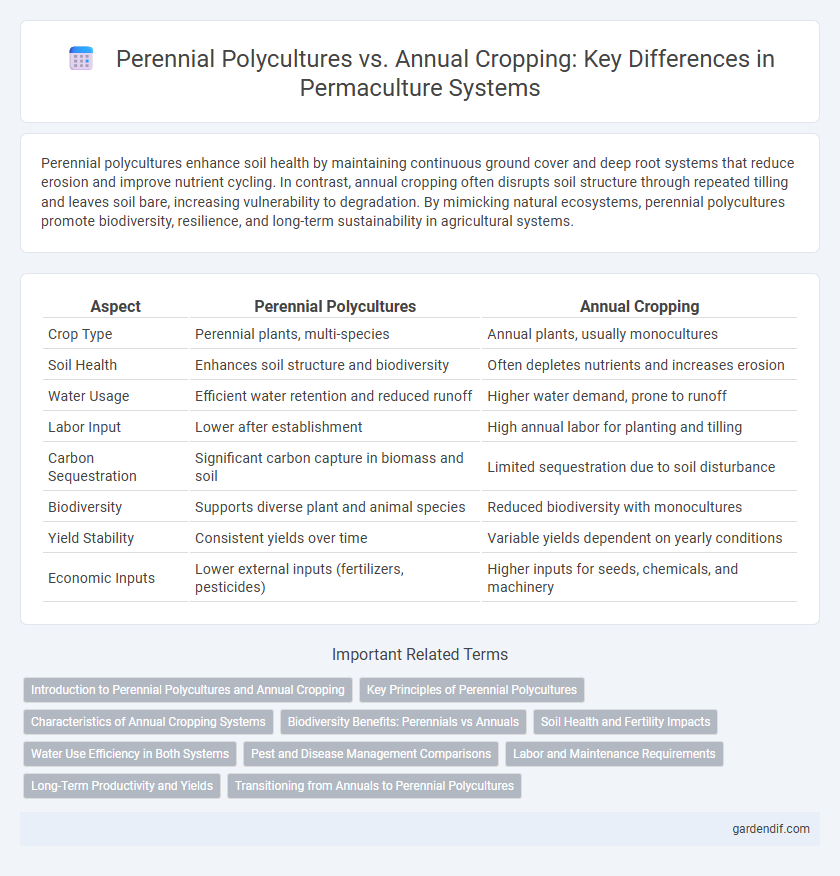
perennial polycultures vs annual cropping Illustration
Perennial polycultures enhance soil health by maintaining continuous ground cover and deep root systems that reduce erosion and improve nutrient cycling. In contrast, annual cropping often disrupts soil structure through repeated tilling and leaves soil bare, increasing vulnerability to degradation. By mimicking natural ecosystems, perennial polycultures promote biodiversity, resilience, and long-term sustainability in agricultural systems.
Table of Comparison
| Aspect | Perennial Polycultures | Annual Cropping |
|---|---|---|
| Crop Type | Perennial plants, multi-species | Annual plants, usually monocultures |
| Soil Health | Enhances soil structure and biodiversity | Often depletes nutrients and increases erosion |
| Water Usage | Efficient water retention and reduced runoff | Higher water demand, prone to runoff |
| Labor Input | Lower after establishment | High annual labor for planting and tilling |
| Carbon Sequestration | Significant carbon capture in biomass and soil | Limited sequestration due to soil disturbance |
| Biodiversity | Supports diverse plant and animal species | Reduced biodiversity with monocultures |
| Yield Stability | Consistent yields over time | Variable yields dependent on yearly conditions |
| Economic Inputs | Lower external inputs (fertilizers, pesticides) | Higher inputs for seeds, chemicals, and machinery |
Introduction to Perennial Polycultures and Annual Cropping
Perennial polycultures integrate multiple long-lived plant species to enhance soil health, biodiversity, and ecosystem stability, reducing the need for annual tilling and chemical inputs. In contrast, annual cropping relies on single-species planting cycles that often degrade soil structure and require intensive resource inputs such as fertilizers and irrigation. Transitioning to perennial polycultures supports sustainable agriculture by promoting continuous ground cover, increased carbon sequestration, and resilience to climate variability.
Key Principles of Perennial Polycultures
Perennial polycultures optimize biodiversity by integrating multiple species that coexist and support each other's growth year-round, enhancing soil health and reducing erosion. This system relies on principles such as deep root systems for nutrient cycling, minimal soil disturbance, and continuous ground cover to maintain ecosystem stability and productivity. Unlike annual cropping, perennial polycultures promote long-term resilience and sustainability by fostering complex plant interactions and reducing the need for external inputs.
Characteristics of Annual Cropping Systems
Annual cropping systems rely on planting and harvesting crops within a single growing season, demanding intensive soil preparation and frequent disturbance. These systems often depend heavily on external inputs like synthetic fertilizers and pesticides to maintain yield and control pests. High susceptibility to soil erosion and nutrient depletion frequently challenges sustainability in annual cropping practices.
Biodiversity Benefits: Perennials vs Annuals
Perennial polycultures enhance biodiversity by providing stable habitats and continuous food sources for pollinators, soil organisms, and wildlife throughout the year. Unlike annual cropping systems that disrupt ecosystems with frequent soil disturbance and monoculture planting, perennials promote complex root networks and diverse plant species, improving soil health and ecosystem resilience. This biodiversity boost supports ecosystem services such as nutrient cycling, pest control, and carbon sequestration more effectively than annual systems.
Soil Health and Fertility Impacts
Perennial polycultures enhance soil health by maintaining continuous ground cover, reducing erosion, and promoting diverse microbial activity, which improves nutrient cycling and soil structure. In contrast, annual cropping often leads to soil disturbance, nutrient depletion, and a decline in organic matter, negatively impacting fertility over time. Integrating perennial species increases carbon sequestration and stabilizes soil ecosystems, fostering long-term agricultural sustainability.
Water Use Efficiency in Both Systems
Perennial polycultures demonstrate significantly higher water use efficiency compared to annual cropping systems by maintaining continuous ground cover and deeper root systems that enhance soil moisture retention and reduce evaporation. Annual crops require frequent irrigation and disturb the soil regularly, leading to increased water loss through runoff and evaporation. Research shows that perennial systems can reduce water input by up to 50% while sustaining comparable or higher yields due to improved soil health and microclimate stabilization.
Pest and Disease Management Comparisons
Perennial polycultures enhance pest and disease management by fostering diverse plant communities that attract beneficial insects and natural predators, reducing the need for chemical interventions. Annual cropping systems often rely on monocultures, which create uniform habitats that can accelerate pest outbreaks and disease spread due to limited biodiversity. Integrating perennial polycultures improves ecosystem resilience and promotes natural pest suppression, leading to healthier crops and reduced reliance on synthetic pesticides.
Labor and Maintenance Requirements
Perennial polycultures significantly reduce labor and maintenance requirements compared to annual cropping systems by minimizing soil disturbance, planting frequency, and irrigation needs. These systems rely on diverse, self-sustaining plant communities that enhance soil fertility and suppress weeds naturally, decreasing the need for manual weeding and synthetic inputs. Over time, labor costs drop substantially as perennial roots stabilize soil and establish efficient nutrient cycling, promoting long-term productivity with minimal intervention.
Long-Term Productivity and Yields
Perennial polycultures enhance long-term productivity by establishing stable root systems that improve soil health, water retention, and nutrient cycling, leading to sustainable yields over time. In contrast, annual cropping often depletes soil nutrients and requires frequent replanting, resulting in fluctuating productivity and increased input costs. Studies show that diverse perennial systems can maintain consistent yields while reducing erosion and the need for chemical fertilizers.
Transitioning from Annuals to Perennial Polycultures
Transitioning from annual cropping systems to perennial polycultures enhances soil health by promoting continuous root presence and reducing erosion. Perennial polycultures improve biodiversity, water retention, and carbon sequestration compared to the intensive tillage and monoculture practices of annual crops. Integrating multiple perennial species creates resilient ecosystems that require fewer inputs and support long-term agricultural sustainability.
perennial polycultures vs annual cropping Infographic

 gardendif.com
gardendif.com